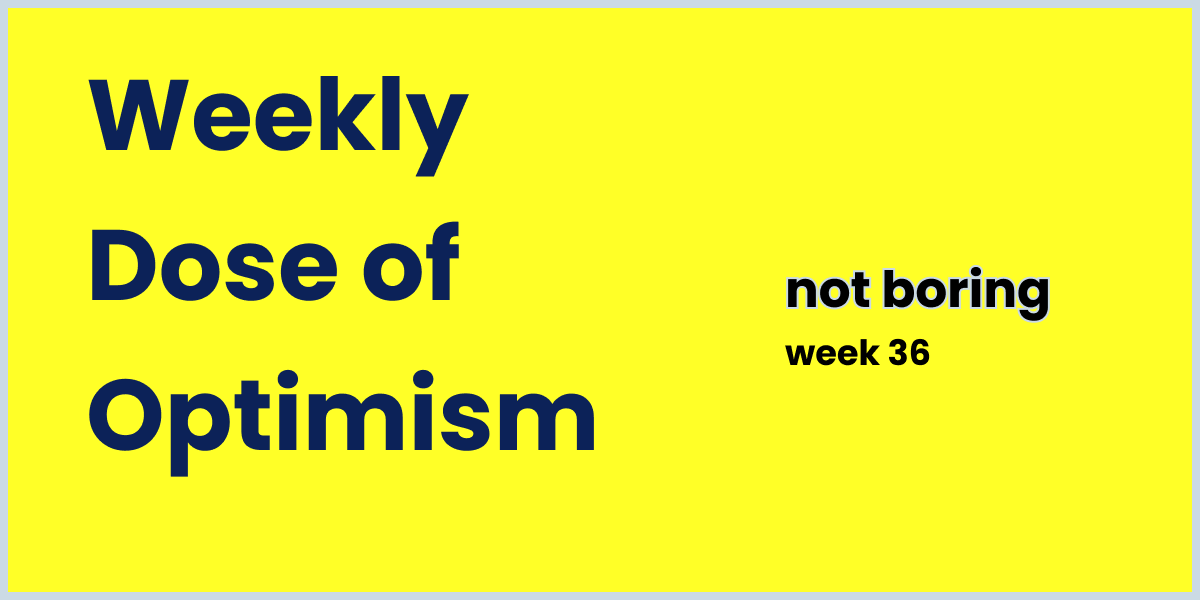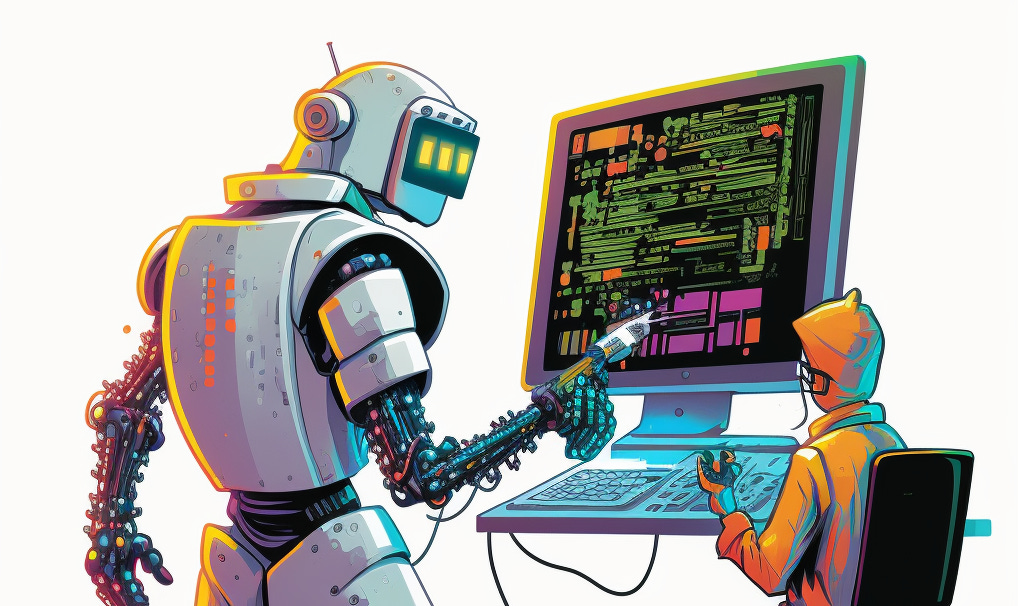

Weekly Dose of Optimism #36
source link: https://www.notboring.co/p/weekly-dose-of-optimism-36
Go to the source link to view the article. You can view the picture content, updated content and better typesetting reading experience. If the link is broken, please click the button below to view the snapshot at that time.

Weekly Dose of Optimism #36
Possible, Malleable Software, Taking the Plunge, Age of Average, Genetic Design
Hi friends 👋,
Happy Friday and welcome back to our 36th Weekly Dose of Optimism.
It’s hard to write a post on optimism the week of another school shooting, this time in Nashville. It’s embarrassing, sad, and pathetic that this keeps happening in America, and that it doesn’t seem like anyone’s willing to do anything about it. Our hearts go out to the victims and their families.
Despite the tragedy, humans did do some pretty amazing things this week, and it’s our job here to try to balance the bad news that streams constantly on the news and your social feeds with the many more good things happening out there.
Let’s get to it.
The Weekly Dose is brought to you by... Create
Create is reversing the creatine stigma with its first-of-its-kind creatine monohydrate gummy.
Readers of the Weekly Dose may not know this, but I (Dan) founded and operate Create. Creatine and newsletters…I couldn’t have predicted this career. But why creatine? 5 Reasons:
Underpenetrated: Less than 2% of the US population regularly takes it. It should be 25x.
Studied & Safe: It’s “Generally Recognized as Safe” by the FDA and is the most studied fitness supplement on the market.
Effective: Ask anyone who’s taken creatine, and they’ll confirm it works for them.
Going Mainstream: In just the last 3 months, Huberman, Attia, Rogan, and Ferriss have all discussed creatine on their respective podcasts…people are catching on.
Beneficial: It’s not only a highly effective fitness supplement, there is a growing body of research that creatine improves brain function: cognition, memory, and mental health.
In just the last 3 months, over 5,000 customers have added our first-of-its-kind creatine monohydrate gummy to their daily routine and 90% of subscribers report that they “look forward to taking their creatine gummies each day.” As a Not Boring reader, you can get 20% off your order with code notboring20.
(1) Possible
From Reid Hoffman and Aria Finger
Possible is a new podcast that sketches out the brightest version of the future—and what it will take to get there. Most of all, it asks: what if, in the future, everything breaks humanity’s way? Each episode has a companion story, generated by GPT-4, which will serve as a jumping-off point for a hopeful, speculative discussion about what humanity could possibly get right if we leverage technology—and our collective effort—effectively.
We’re not alone in our quest to spread optimism. Reid Hoffman, along with co-host Aria Finger, launched a new podcast with a twist. Each episode, they explore the brightest version of the future of a specific topic — so far entertainment, fusion, and clean energy. The twist is that after exploring this future with a guest, they also prompt ChatGPT to explore that bright future as well…and compare how the two match up.
✅ Reid Hoffman podcast (big Masters of Scale fans)
✅ Optimistic storytelling and exploration
✅ Working in ChatGPT into the podcast about the future of entertainment, very meta!
In the episode linked above, Trevor Noah shared his perspective on the relationship between technology and optimism, saying, “In order to be a technologist, you have to be an optimist because you have to believe the future you’re designing for will exist or you have to believe that what you’re creating will contribute to that future.”
Amen Trevor.
(2) Malleable software in the age of LLMs
From Geoffrey Litt
All computer users may soon have the ability to author small bits of code. What structural changes does this imply for the production and distribution of software?
Litt explores the implications of LLM on the democratization of software creation. What happens when everyone, with a little bit (OK, a lot of bit) of help from their friendly LLM assistant, can write code? As Litt views it, a more democratic digital landscape in which end-users create and control software that fit their specific needs.
LLMs help 'Liberate the Last Mile,” or the final leg that would-be developers need to traverse to execute code. Us normies have all been there — we have a great idea, maybe even have a bit of technical chops, but can’t bridge the gap between insights and actually deploying a useful piece of software. Essentially, writing and executing code from end-to-end is a lot more complex than it looks, and LLMs represent a step-change in a normal person’s ability to do so.
As someone who is deeply fascinated by tech, but can’t really code (any often gets caught up in the Last Mile when I try), this is a super exciting vision. For top professional developers, I don’t anticipate LLMs will make them obsolete, but instead allow them to focus on more and more complex problems.
(3) Existential risk, AI, and the inevitable turn in human history
Tyler Cowen for Marginal Revolution
I would put it this way. Our previous stasis, as represented by my #1 and #2, is going to end anyway. We are going to face that radical uncertainty anyway. And probably pretty soon. So there is no “ongoing stasis” option on the table.
This was a big week for the AI safety debate, kicked off by this Marginal Revolution post by Tyler Cowen, followed by an open letter calling for a 6-month pause to “giant AI experiments” signed by Elon Musk, Steve Wozniak, Max Tegmark, and others, and capped off by an even more extreme call to “shut it all down” by Eliezer Yudkowsky in Time.
How AI is going to impact society — from how it will impact jobs and meaning to whether it’s going to kill us all — is an important conversation, and even the AI optimists believe it’s one we should be having. Sam Altman talked about it on Lex Fridman and Nat Friedman talked about it on The Lunar Society.
When things are moving so fast, and are so uncertain, it’s useful to step back and take the historical perspective, which Cowen did beautifully in his post. He argues that during recent times, most of us have been living in a bubble “outside of history” for two main reasons:
American hegemony over much of the world, and relative physical safety for Americans.
An absence of truly radical technological change.
AI represents the end of #2 (and Ukraine/Taiwan may represent the end of #1) and all of a sudden, we’re going to be living inside of “actual ‘moving’ history. It will panic many of us, disorient the rest of us, and cause great upheavals in our fortunes, both good and bad.”
Cowen believes that the good will outweigh the bad, but more centrally to the piece, he argues that whatever happens, our previous stasis is going to end anyway and no one — neither the doomers nor the optimists — knows how it’s going to turn out. In his view, the question is no longer “go ahead?” but rather “given that we’re going forward with this, what good can we get out of it?”
We can’t change the direction of progress’ arrow; in SlateStarCodex’s words, we are the Puppets and technological progress is “the vastest and most formless Vast Formless Thing of all.” We can only fight to make the positive outcomes vastly outweigh the inevitable negative ones.
The closing paragraphs capture our kind of optimism well — of course there will be challenges, but we’re here to overcomes
Besides, what kind of civilization is it that turns away from the challenge of dealing with more…intelligence? That has not the self-confidence to confidently confront a big dose of more intelligence? Dare I wonder if such societies might not perish under their current watch, with or without AI? Do you really want to press the button, giving us that kind of American civilization?
So we should take the plunge. If someone is obsessively arguing about the details of AI technology today, and the arguments on LessWrong from eleven years ago, they won’t see this. Don’t be suckered into taking their bait. The longer a historical perspective you take, the more obvious this point will be. We should take the plunge. We already have taken the plunge. We designed/tolerated our decentralized society so we could take the plunge.
See you all on the other side.
From Alex Murrell
I believe that the age of average is the age of opportunity…So, this is your call to arms. Whether you’re in film or fashion, media or marketing, architecture, automotive or advertising, it doesn’t matter. Our visual culture is flatlining and the only cure is creativity. It’s time to cast aside conformity. It’s time to exorcise the expected. It’s time to decline the indistinguishable.
OK, to be fair, Murrell’s estimation of the world isn’t overly optimistic…but unfortunately, appears to be pretty accurate. The article argues that “creative fields have become dominated and defined by convention and cliché” and this has led to everything looking the same. Airbnbs have the same interior decoration. Coffee shops in Copenhagen and Nashville go for the same vibe. Modern brands, regardless of what they are selling, have the same sans serif copy and playful color scheme. Even models (see above) all adopt the same “Instagram Face.”
This is not necessarily a bad thing — places, things, and people conform to what people like or has proven to be successful. Something starts off as new and unique, this attracts attention, and copycats — realizing the best strategy is to copy first, and differentiate later, soon follow. But it does lead to a world, ultimately, in which everything looks the same.
There are two ways to view this:
Everything looks the same; therefore creativity is dead OR
Everything looks the same; therefore there is an opportunity for creativity to thrive.
We tend to subscribe to the latter world view. As more creative work is aided by AI, we can envision where the sameness issue gets even worse. That means there will be a growing premium on folks who can produce the different.
(5) Accelerating Genetic Design
Elliot Hershberg for Century of Biology
(Elliot, a Not Boring Bio Partner, provided a short summary of his recent essay below, but the whole essay is worth a read!)
Biology is rapidly making the transition from a natural science to an engineering discipline. In large part, this is driven by exponential progress in genetic technologies—specifically DNA sequencing and synthesis. Together, these tools can produce massive data sets that make even the “big data” of the Internet Age look small. This opens the door to building powerful predictive models of biological systems using AI. I refer to this paradigm as the 4-S model, and it’s poised to dramatically change our relationship with our bodies and our planet.
The main application of this tool stack so far has been to engineer new types of proteins—which are the molecular machines that make up our bodies. We can rapidly synthesize variations of these molecules and test their behavior using DNA sequencing. This is pretty cool. Engineering new molecules and proteins has produced new cellular receptors that can convince immune cells to cure cancer, and enzymes that power chemical plants that produce no waste.
Ultimately, proteins and other molecules are individual parts that are composed into more complex circuits within cells. A longstanding challenge for the field of synthetic biology has been to move up a layer of abstraction and reliably engineer new genetic circuits. This type of progress would unlock a future of programmable medicines and materials, where our medicines—and maybe someday our clothes, buildings, and physical infrastructure—flexibly adapt and compute based on their environment.
In this recent essay, I explain exciting new research from a synthetic biology lab at Rice University that aims to accelerate genetic circuit design by leveraging recent advances in DNA sequencing. It’s a great example of the promise at the intersection of genetic engineering and AI. Could we someday produce a ChatGPT that speaks the language of cells? Come for the cool Matroyshka doll art, stay for a primer on AI-driven biodesign.
Did you enjoy reading this Weekly Dose of Optimism?
(Powered by Sprig)
That’s all for this week. We’ll be back in your inbox on Monday.
Thanks for reading,
Recommend
About Joyk
Aggregate valuable and interesting links.
Joyk means Joy of geeK




